Exploring the Public Image of Nursing: A Critical Analysis
VerifiedAdded on 2022/09/15
|9
|2244
|16
Essay
AI Summary
This essay provides a critical discussion of the public image of nursing, exploring how nurses are perceived by the public and how they view themselves. It delves into the historical context, examining the evolution of nursing's image from the 'angel of mercy' to the modern healthcare professional. The essay analyzes the impact of public stereotypes, media portrayals, and the nurse-doctor relationship on nursing practice and professionalization. It highlights the importance of nurses' roles as caregivers, decision-makers, educators, communicators, and advocates, while also addressing the challenges posed by limited autonomy and societal misconceptions. The essay concludes by emphasizing the need for collaboration and mutual recognition to improve the public image of nursing and support its continued professional development. Furthermore, the essay explores the historical context of nursing, highlighting the influence of figures like Florence Nightingale and the impact of gender-based stereotypes on the profession. It also discusses the impact of these perceptions on the nurse-doctor relationship, and how the lack of independence and autonomy can limit full nursing practice.
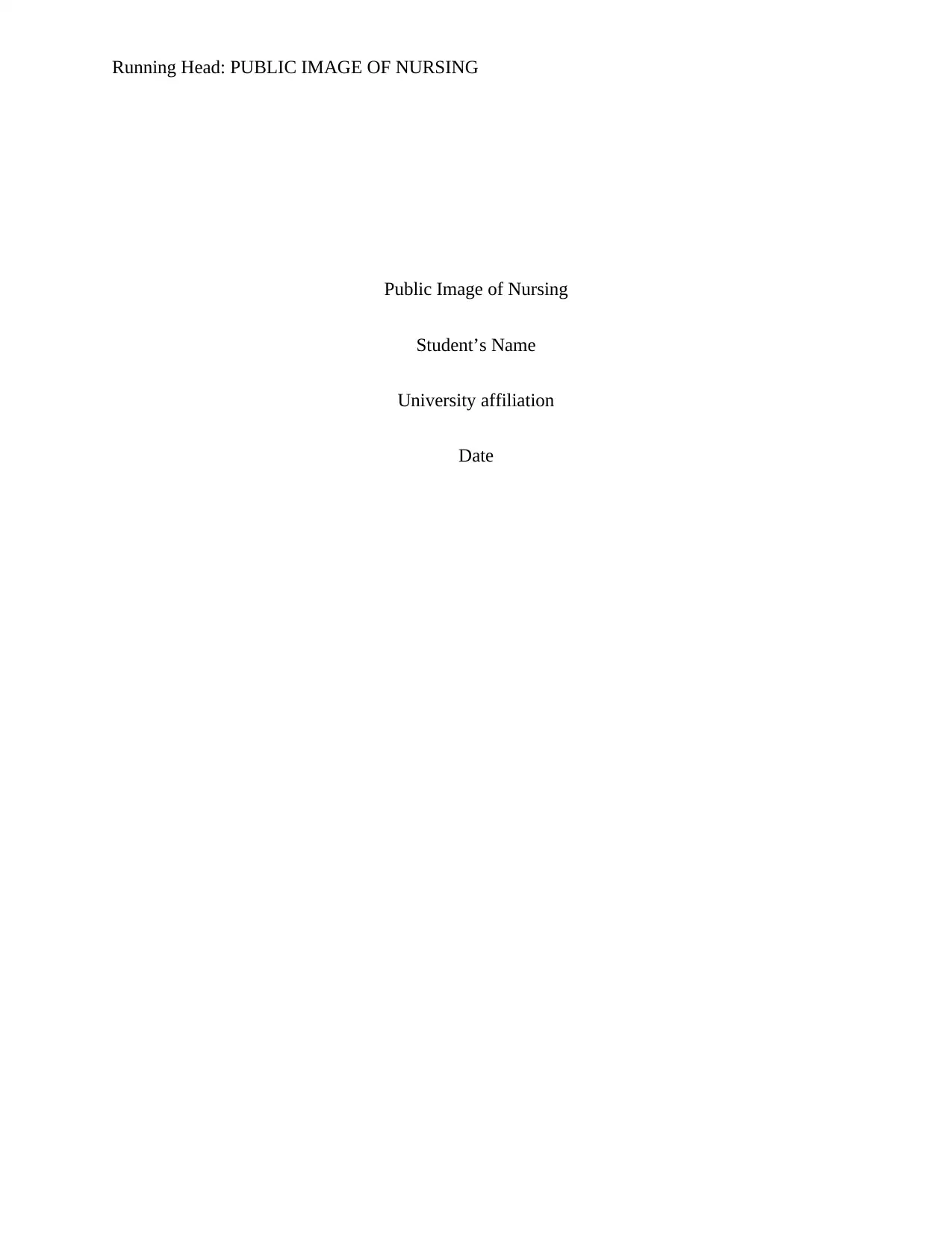
Running Head: PUBLIC IMAGE OF NURSING
Public Image of Nursing
Student’s Name
University affiliation
Date
Public Image of Nursing
Student’s Name
University affiliation
Date
Paraphrase This Document
Need a fresh take? Get an instant paraphrase of this document with our AI Paraphraser
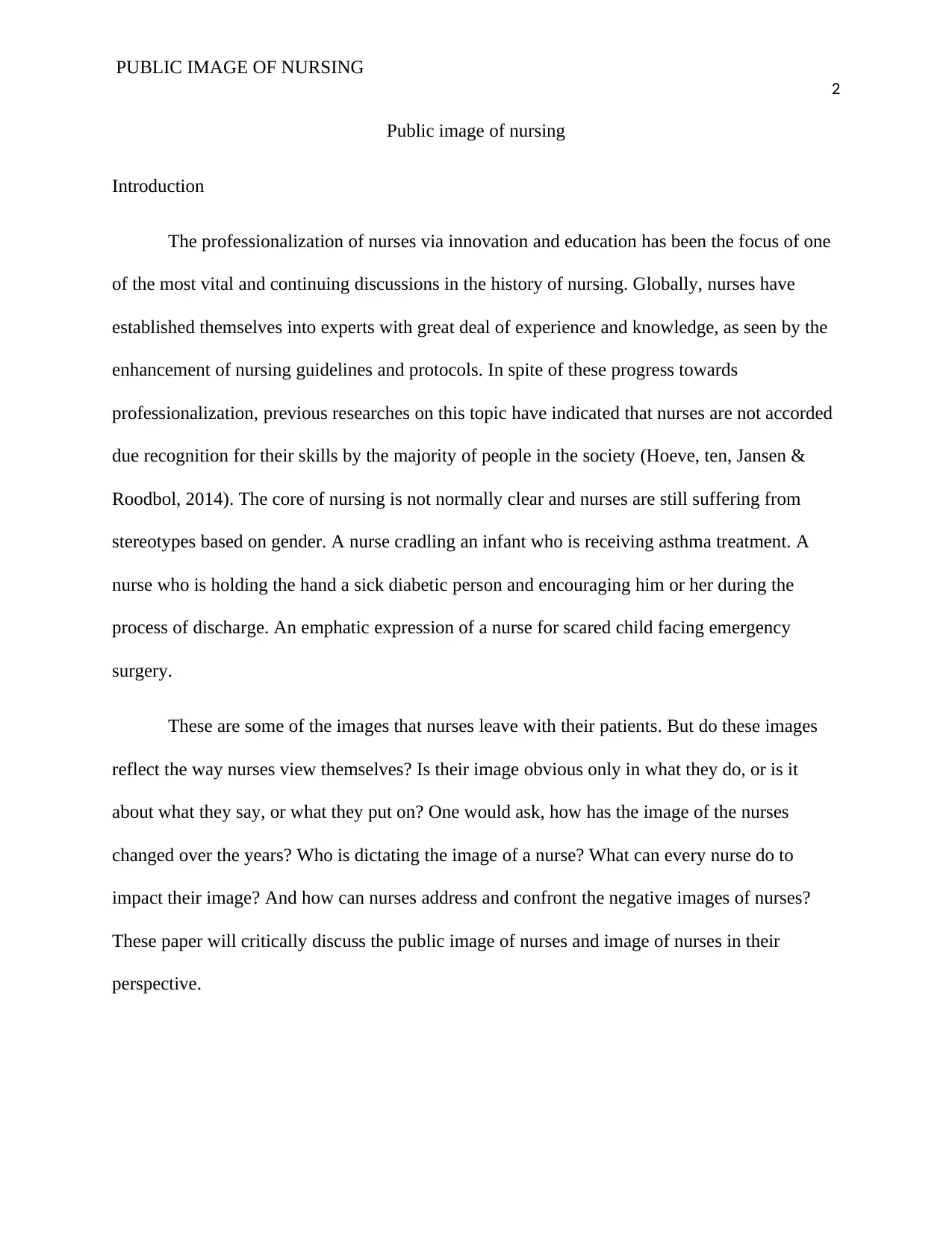
PUBLIC IMAGE OF NURSING
2
Public image of nursing
Introduction
The professionalization of nurses via innovation and education has been the focus of one
of the most vital and continuing discussions in the history of nursing. Globally, nurses have
established themselves into experts with great deal of experience and knowledge, as seen by the
enhancement of nursing guidelines and protocols. In spite of these progress towards
professionalization, previous researches on this topic have indicated that nurses are not accorded
due recognition for their skills by the majority of people in the society (Hoeve, ten, Jansen &
Roodbol, 2014). The core of nursing is not normally clear and nurses are still suffering from
stereotypes based on gender. A nurse cradling an infant who is receiving asthma treatment. A
nurse who is holding the hand a sick diabetic person and encouraging him or her during the
process of discharge. An emphatic expression of a nurse for scared child facing emergency
surgery.
These are some of the images that nurses leave with their patients. But do these images
reflect the way nurses view themselves? Is their image obvious only in what they do, or is it
about what they say, or what they put on? One would ask, how has the image of the nurses
changed over the years? Who is dictating the image of a nurse? What can every nurse do to
impact their image? And how can nurses address and confront the negative images of nurses?
These paper will critically discuss the public image of nurses and image of nurses in their
perspective.
2
Public image of nursing
Introduction
The professionalization of nurses via innovation and education has been the focus of one
of the most vital and continuing discussions in the history of nursing. Globally, nurses have
established themselves into experts with great deal of experience and knowledge, as seen by the
enhancement of nursing guidelines and protocols. In spite of these progress towards
professionalization, previous researches on this topic have indicated that nurses are not accorded
due recognition for their skills by the majority of people in the society (Hoeve, ten, Jansen &
Roodbol, 2014). The core of nursing is not normally clear and nurses are still suffering from
stereotypes based on gender. A nurse cradling an infant who is receiving asthma treatment. A
nurse who is holding the hand a sick diabetic person and encouraging him or her during the
process of discharge. An emphatic expression of a nurse for scared child facing emergency
surgery.
These are some of the images that nurses leave with their patients. But do these images
reflect the way nurses view themselves? Is their image obvious only in what they do, or is it
about what they say, or what they put on? One would ask, how has the image of the nurses
changed over the years? Who is dictating the image of a nurse? What can every nurse do to
impact their image? And how can nurses address and confront the negative images of nurses?
These paper will critically discuss the public image of nurses and image of nurses in their
perspective.
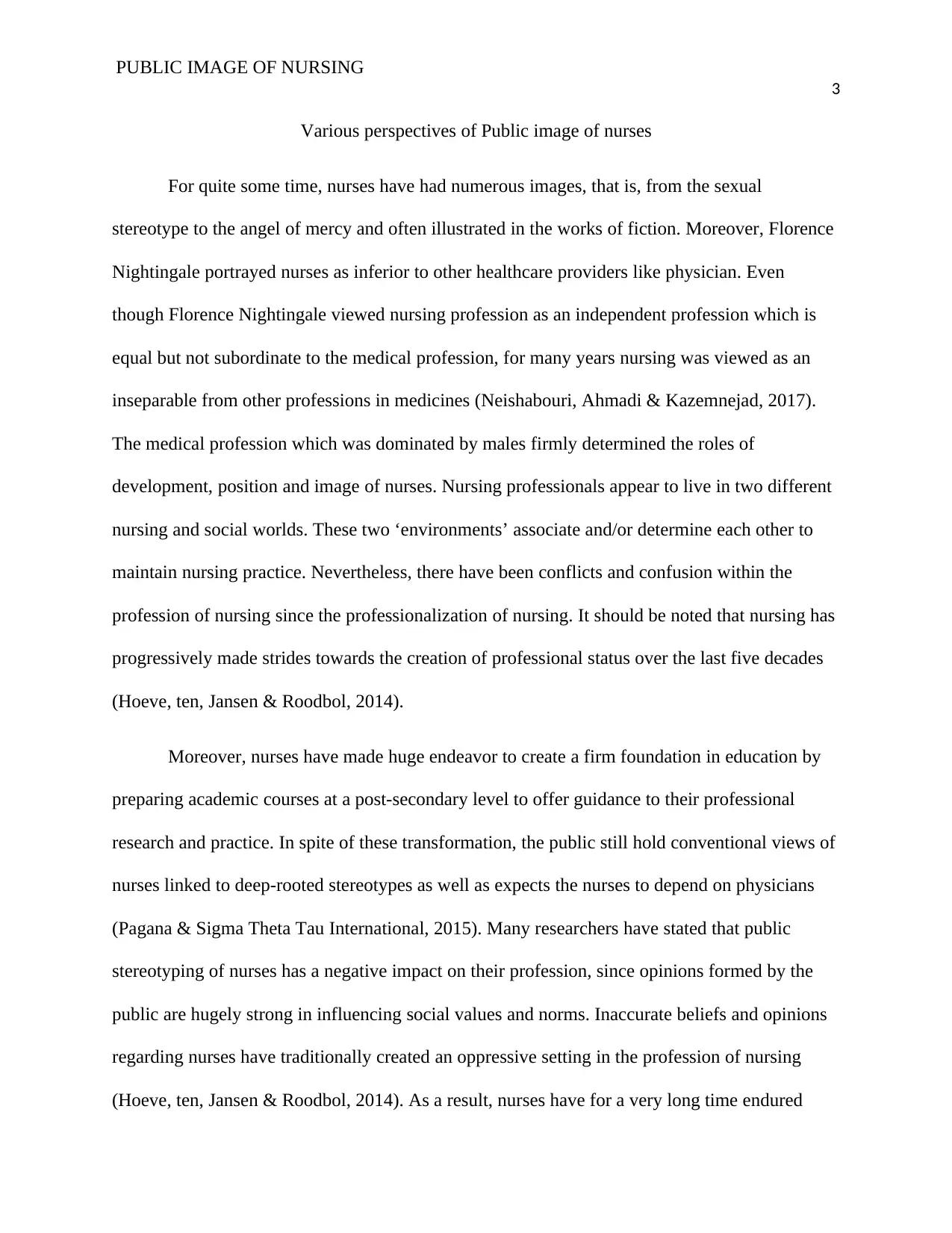
PUBLIC IMAGE OF NURSING
3
Various perspectives of Public image of nurses
For quite some time, nurses have had numerous images, that is, from the sexual
stereotype to the angel of mercy and often illustrated in the works of fiction. Moreover, Florence
Nightingale portrayed nurses as inferior to other healthcare providers like physician. Even
though Florence Nightingale viewed nursing profession as an independent profession which is
equal but not subordinate to the medical profession, for many years nursing was viewed as an
inseparable from other professions in medicines (Neishabouri, Ahmadi & Kazemnejad, 2017).
The medical profession which was dominated by males firmly determined the roles of
development, position and image of nurses. Nursing professionals appear to live in two different
nursing and social worlds. These two ‘environments’ associate and/or determine each other to
maintain nursing practice. Nevertheless, there have been conflicts and confusion within the
profession of nursing since the professionalization of nursing. It should be noted that nursing has
progressively made strides towards the creation of professional status over the last five decades
(Hoeve, ten, Jansen & Roodbol, 2014).
Moreover, nurses have made huge endeavor to create a firm foundation in education by
preparing academic courses at a post-secondary level to offer guidance to their professional
research and practice. In spite of these transformation, the public still hold conventional views of
nurses linked to deep-rooted stereotypes as well as expects the nurses to depend on physicians
(Pagana & Sigma Theta Tau International, 2015). Many researchers have stated that public
stereotyping of nurses has a negative impact on their profession, since opinions formed by the
public are hugely strong in influencing social values and norms. Inaccurate beliefs and opinions
regarding nurses have traditionally created an oppressive setting in the profession of nursing
(Hoeve, ten, Jansen & Roodbol, 2014). As a result, nurses have for a very long time endured
3
Various perspectives of Public image of nurses
For quite some time, nurses have had numerous images, that is, from the sexual
stereotype to the angel of mercy and often illustrated in the works of fiction. Moreover, Florence
Nightingale portrayed nurses as inferior to other healthcare providers like physician. Even
though Florence Nightingale viewed nursing profession as an independent profession which is
equal but not subordinate to the medical profession, for many years nursing was viewed as an
inseparable from other professions in medicines (Neishabouri, Ahmadi & Kazemnejad, 2017).
The medical profession which was dominated by males firmly determined the roles of
development, position and image of nurses. Nursing professionals appear to live in two different
nursing and social worlds. These two ‘environments’ associate and/or determine each other to
maintain nursing practice. Nevertheless, there have been conflicts and confusion within the
profession of nursing since the professionalization of nursing. It should be noted that nursing has
progressively made strides towards the creation of professional status over the last five decades
(Hoeve, ten, Jansen & Roodbol, 2014).
Moreover, nurses have made huge endeavor to create a firm foundation in education by
preparing academic courses at a post-secondary level to offer guidance to their professional
research and practice. In spite of these transformation, the public still hold conventional views of
nurses linked to deep-rooted stereotypes as well as expects the nurses to depend on physicians
(Pagana & Sigma Theta Tau International, 2015). Many researchers have stated that public
stereotyping of nurses has a negative impact on their profession, since opinions formed by the
public are hugely strong in influencing social values and norms. Inaccurate beliefs and opinions
regarding nurses have traditionally created an oppressive setting in the profession of nursing
(Hoeve, ten, Jansen & Roodbol, 2014). As a result, nurses have for a very long time endured
⊘ This is a preview!⊘
Do you want full access?
Subscribe today to unlock all pages.

Trusted by 1+ million students worldwide
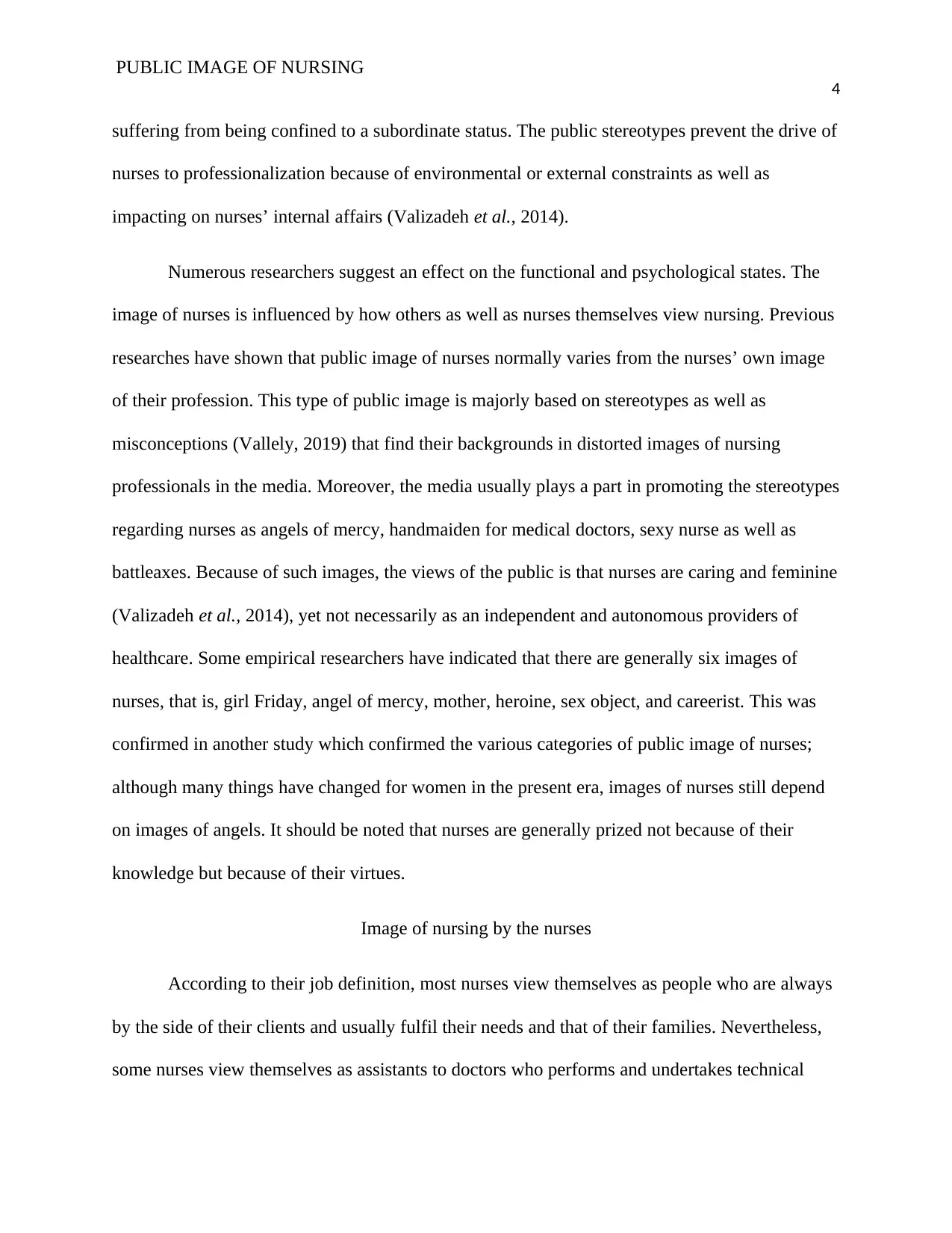
PUBLIC IMAGE OF NURSING
4
suffering from being confined to a subordinate status. The public stereotypes prevent the drive of
nurses to professionalization because of environmental or external constraints as well as
impacting on nurses’ internal affairs (Valizadeh et al., 2014).
Numerous researchers suggest an effect on the functional and psychological states. The
image of nurses is influenced by how others as well as nurses themselves view nursing. Previous
researches have shown that public image of nurses normally varies from the nurses’ own image
of their profession. This type of public image is majorly based on stereotypes as well as
misconceptions (Vallely, 2019) that find their backgrounds in distorted images of nursing
professionals in the media. Moreover, the media usually plays a part in promoting the stereotypes
regarding nurses as angels of mercy, handmaiden for medical doctors, sexy nurse as well as
battleaxes. Because of such images, the views of the public is that nurses are caring and feminine
(Valizadeh et al., 2014), yet not necessarily as an independent and autonomous providers of
healthcare. Some empirical researchers have indicated that there are generally six images of
nurses, that is, girl Friday, angel of mercy, mother, heroine, sex object, and careerist. This was
confirmed in another study which confirmed the various categories of public image of nurses;
although many things have changed for women in the present era, images of nurses still depend
on images of angels. It should be noted that nurses are generally prized not because of their
knowledge but because of their virtues.
Image of nursing by the nurses
According to their job definition, most nurses view themselves as people who are always
by the side of their clients and usually fulfil their needs and that of their families. Nevertheless,
some nurses view themselves as assistants to doctors who performs and undertakes technical
4
suffering from being confined to a subordinate status. The public stereotypes prevent the drive of
nurses to professionalization because of environmental or external constraints as well as
impacting on nurses’ internal affairs (Valizadeh et al., 2014).
Numerous researchers suggest an effect on the functional and psychological states. The
image of nurses is influenced by how others as well as nurses themselves view nursing. Previous
researches have shown that public image of nurses normally varies from the nurses’ own image
of their profession. This type of public image is majorly based on stereotypes as well as
misconceptions (Vallely, 2019) that find their backgrounds in distorted images of nursing
professionals in the media. Moreover, the media usually plays a part in promoting the stereotypes
regarding nurses as angels of mercy, handmaiden for medical doctors, sexy nurse as well as
battleaxes. Because of such images, the views of the public is that nurses are caring and feminine
(Valizadeh et al., 2014), yet not necessarily as an independent and autonomous providers of
healthcare. Some empirical researchers have indicated that there are generally six images of
nurses, that is, girl Friday, angel of mercy, mother, heroine, sex object, and careerist. This was
confirmed in another study which confirmed the various categories of public image of nurses;
although many things have changed for women in the present era, images of nurses still depend
on images of angels. It should be noted that nurses are generally prized not because of their
knowledge but because of their virtues.
Image of nursing by the nurses
According to their job definition, most nurses view themselves as people who are always
by the side of their clients and usually fulfil their needs and that of their families. Nevertheless,
some nurses view themselves as assistants to doctors who performs and undertakes technical
Paraphrase This Document
Need a fresh take? Get an instant paraphrase of this document with our AI Paraphraser
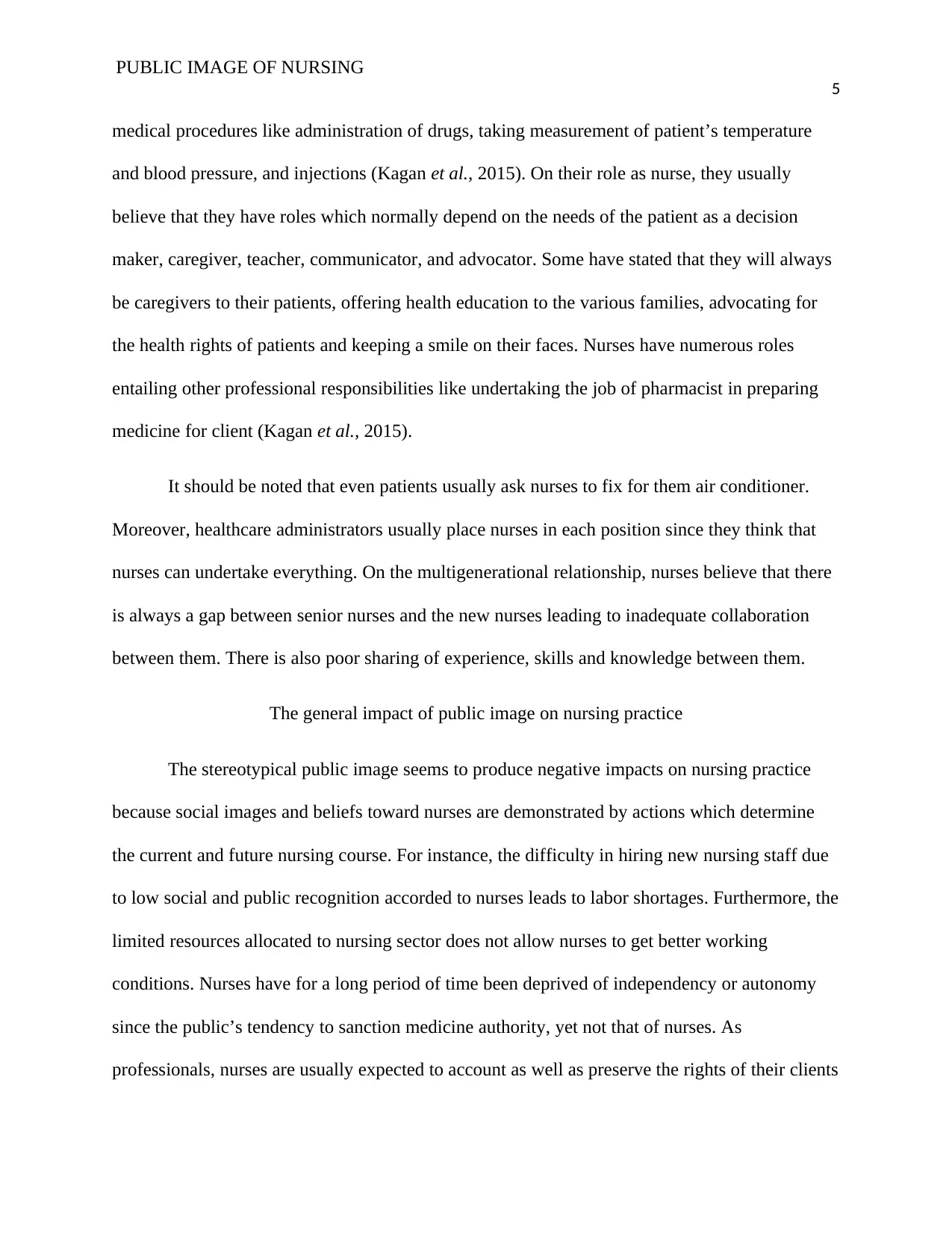
PUBLIC IMAGE OF NURSING
5
medical procedures like administration of drugs, taking measurement of patient’s temperature
and blood pressure, and injections (Kagan et al., 2015). On their role as nurse, they usually
believe that they have roles which normally depend on the needs of the patient as a decision
maker, caregiver, teacher, communicator, and advocator. Some have stated that they will always
be caregivers to their patients, offering health education to the various families, advocating for
the health rights of patients and keeping a smile on their faces. Nurses have numerous roles
entailing other professional responsibilities like undertaking the job of pharmacist in preparing
medicine for client (Kagan et al., 2015).
It should be noted that even patients usually ask nurses to fix for them air conditioner.
Moreover, healthcare administrators usually place nurses in each position since they think that
nurses can undertake everything. On the multigenerational relationship, nurses believe that there
is always a gap between senior nurses and the new nurses leading to inadequate collaboration
between them. There is also poor sharing of experience, skills and knowledge between them.
The general impact of public image on nursing practice
The stereotypical public image seems to produce negative impacts on nursing practice
because social images and beliefs toward nurses are demonstrated by actions which determine
the current and future nursing course. For instance, the difficulty in hiring new nursing staff due
to low social and public recognition accorded to nurses leads to labor shortages. Furthermore, the
limited resources allocated to nursing sector does not allow nurses to get better working
conditions. Nurses have for a long period of time been deprived of independency or autonomy
since the public’s tendency to sanction medicine authority, yet not that of nurses. As
professionals, nurses are usually expected to account as well as preserve the rights of their clients
5
medical procedures like administration of drugs, taking measurement of patient’s temperature
and blood pressure, and injections (Kagan et al., 2015). On their role as nurse, they usually
believe that they have roles which normally depend on the needs of the patient as a decision
maker, caregiver, teacher, communicator, and advocator. Some have stated that they will always
be caregivers to their patients, offering health education to the various families, advocating for
the health rights of patients and keeping a smile on their faces. Nurses have numerous roles
entailing other professional responsibilities like undertaking the job of pharmacist in preparing
medicine for client (Kagan et al., 2015).
It should be noted that even patients usually ask nurses to fix for them air conditioner.
Moreover, healthcare administrators usually place nurses in each position since they think that
nurses can undertake everything. On the multigenerational relationship, nurses believe that there
is always a gap between senior nurses and the new nurses leading to inadequate collaboration
between them. There is also poor sharing of experience, skills and knowledge between them.
The general impact of public image on nursing practice
The stereotypical public image seems to produce negative impacts on nursing practice
because social images and beliefs toward nurses are demonstrated by actions which determine
the current and future nursing course. For instance, the difficulty in hiring new nursing staff due
to low social and public recognition accorded to nurses leads to labor shortages. Furthermore, the
limited resources allocated to nursing sector does not allow nurses to get better working
conditions. Nurses have for a long period of time been deprived of independency or autonomy
since the public’s tendency to sanction medicine authority, yet not that of nurses. As
professionals, nurses are usually expected to account as well as preserve the rights of their clients
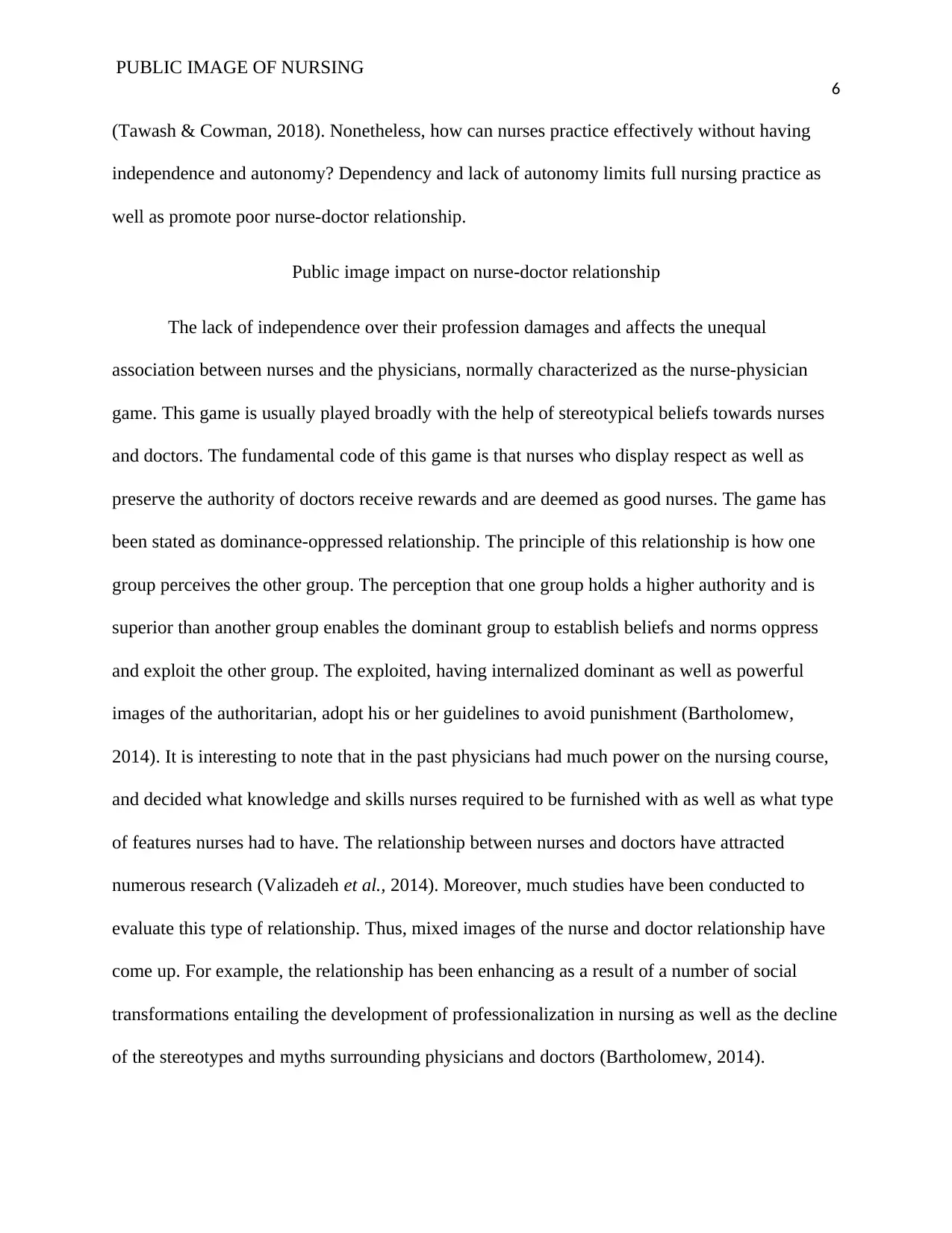
PUBLIC IMAGE OF NURSING
6
(Tawash & Cowman, 2018). Nonetheless, how can nurses practice effectively without having
independence and autonomy? Dependency and lack of autonomy limits full nursing practice as
well as promote poor nurse-doctor relationship.
Public image impact on nurse-doctor relationship
The lack of independence over their profession damages and affects the unequal
association between nurses and the physicians, normally characterized as the nurse-physician
game. This game is usually played broadly with the help of stereotypical beliefs towards nurses
and doctors. The fundamental code of this game is that nurses who display respect as well as
preserve the authority of doctors receive rewards and are deemed as good nurses. The game has
been stated as dominance-oppressed relationship. The principle of this relationship is how one
group perceives the other group. The perception that one group holds a higher authority and is
superior than another group enables the dominant group to establish beliefs and norms oppress
and exploit the other group. The exploited, having internalized dominant as well as powerful
images of the authoritarian, adopt his or her guidelines to avoid punishment (Bartholomew,
2014). It is interesting to note that in the past physicians had much power on the nursing course,
and decided what knowledge and skills nurses required to be furnished with as well as what type
of features nurses had to have. The relationship between nurses and doctors have attracted
numerous research (Valizadeh et al., 2014). Moreover, much studies have been conducted to
evaluate this type of relationship. Thus, mixed images of the nurse and doctor relationship have
come up. For example, the relationship has been enhancing as a result of a number of social
transformations entailing the development of professionalization in nursing as well as the decline
of the stereotypes and myths surrounding physicians and doctors (Bartholomew, 2014).
6
(Tawash & Cowman, 2018). Nonetheless, how can nurses practice effectively without having
independence and autonomy? Dependency and lack of autonomy limits full nursing practice as
well as promote poor nurse-doctor relationship.
Public image impact on nurse-doctor relationship
The lack of independence over their profession damages and affects the unequal
association between nurses and the physicians, normally characterized as the nurse-physician
game. This game is usually played broadly with the help of stereotypical beliefs towards nurses
and doctors. The fundamental code of this game is that nurses who display respect as well as
preserve the authority of doctors receive rewards and are deemed as good nurses. The game has
been stated as dominance-oppressed relationship. The principle of this relationship is how one
group perceives the other group. The perception that one group holds a higher authority and is
superior than another group enables the dominant group to establish beliefs and norms oppress
and exploit the other group. The exploited, having internalized dominant as well as powerful
images of the authoritarian, adopt his or her guidelines to avoid punishment (Bartholomew,
2014). It is interesting to note that in the past physicians had much power on the nursing course,
and decided what knowledge and skills nurses required to be furnished with as well as what type
of features nurses had to have. The relationship between nurses and doctors have attracted
numerous research (Valizadeh et al., 2014). Moreover, much studies have been conducted to
evaluate this type of relationship. Thus, mixed images of the nurse and doctor relationship have
come up. For example, the relationship has been enhancing as a result of a number of social
transformations entailing the development of professionalization in nursing as well as the decline
of the stereotypes and myths surrounding physicians and doctors (Bartholomew, 2014).
⊘ This is a preview!⊘
Do you want full access?
Subscribe today to unlock all pages.

Trusted by 1+ million students worldwide
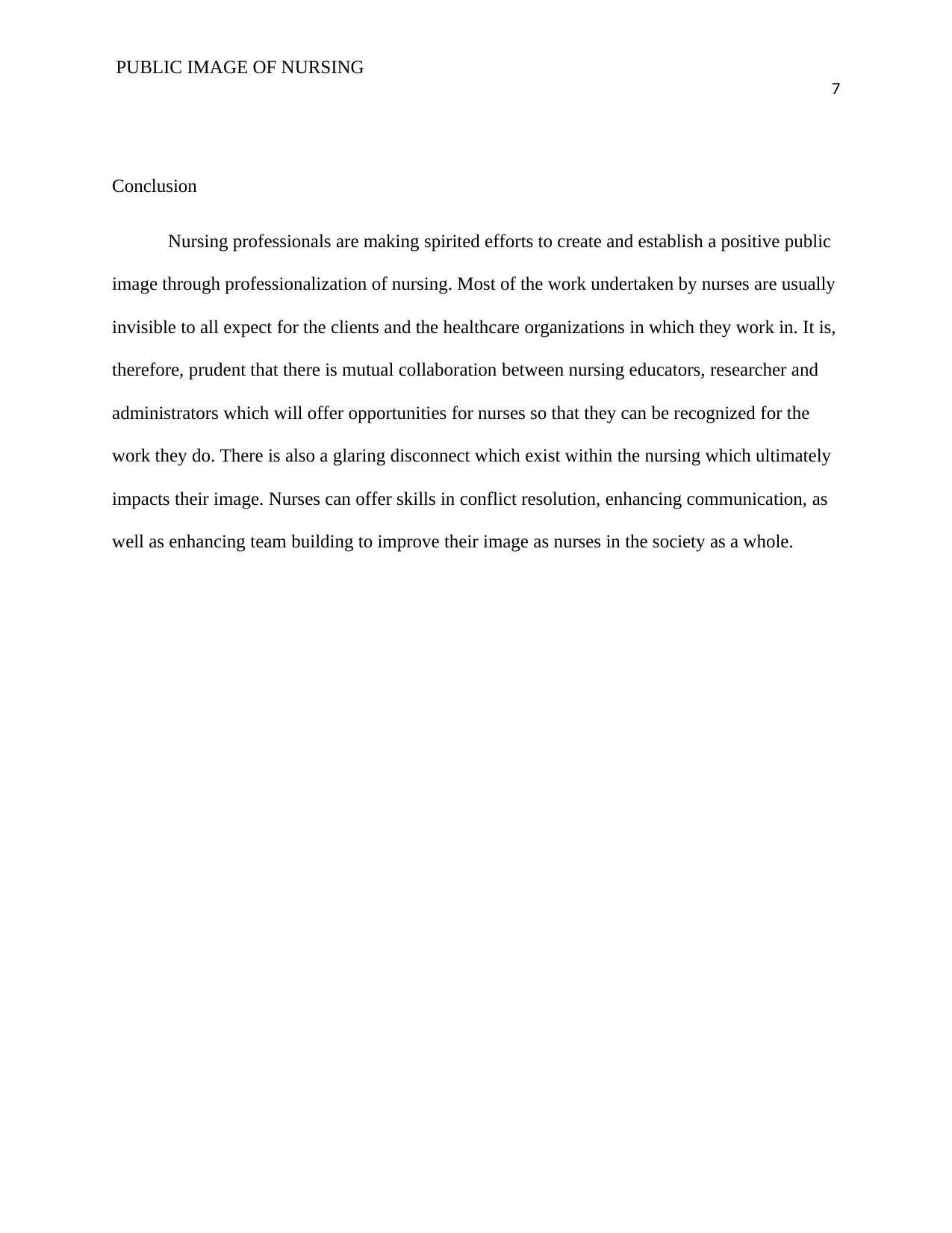
PUBLIC IMAGE OF NURSING
7
Conclusion
Nursing professionals are making spirited efforts to create and establish a positive public
image through professionalization of nursing. Most of the work undertaken by nurses are usually
invisible to all expect for the clients and the healthcare organizations in which they work in. It is,
therefore, prudent that there is mutual collaboration between nursing educators, researcher and
administrators which will offer opportunities for nurses so that they can be recognized for the
work they do. There is also a glaring disconnect which exist within the nursing which ultimately
impacts their image. Nurses can offer skills in conflict resolution, enhancing communication, as
well as enhancing team building to improve their image as nurses in the society as a whole.
7
Conclusion
Nursing professionals are making spirited efforts to create and establish a positive public
image through professionalization of nursing. Most of the work undertaken by nurses are usually
invisible to all expect for the clients and the healthcare organizations in which they work in. It is,
therefore, prudent that there is mutual collaboration between nursing educators, researcher and
administrators which will offer opportunities for nurses so that they can be recognized for the
work they do. There is also a glaring disconnect which exist within the nursing which ultimately
impacts their image. Nurses can offer skills in conflict resolution, enhancing communication, as
well as enhancing team building to improve their image as nurses in the society as a whole.
Paraphrase This Document
Need a fresh take? Get an instant paraphrase of this document with our AI Paraphraser
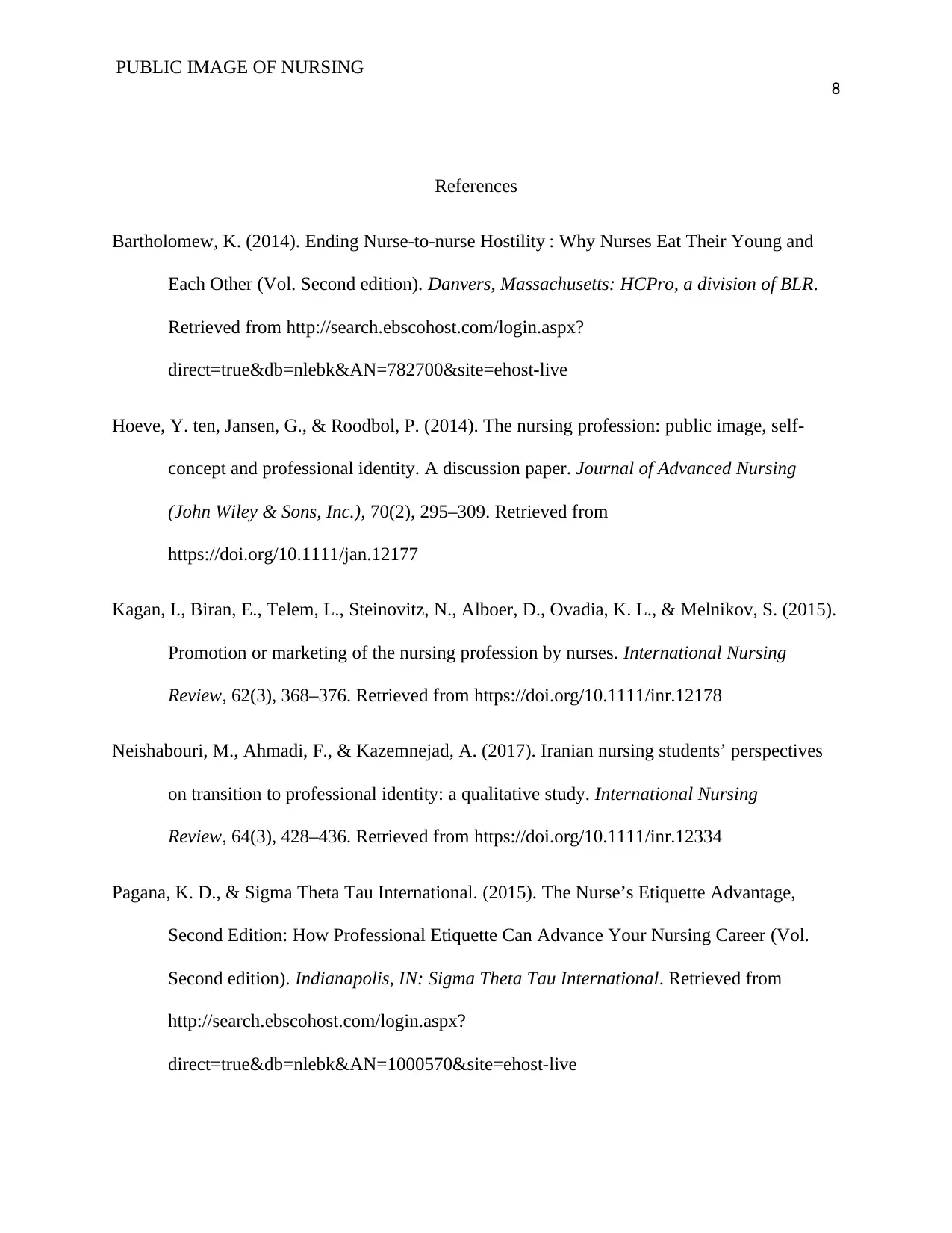
PUBLIC IMAGE OF NURSING
8
References
Bartholomew, K. (2014). Ending Nurse-to-nurse Hostility : Why Nurses Eat Their Young and
Each Other (Vol. Second edition). Danvers, Massachusetts: HCPro, a division of BLR.
Retrieved from http://search.ebscohost.com/login.aspx?
direct=true&db=nlebk&AN=782700&site=ehost-live
Hoeve, Y. ten, Jansen, G., & Roodbol, P. (2014). The nursing profession: public image, self-
concept and professional identity. A discussion paper. Journal of Advanced Nursing
(John Wiley & Sons, Inc.), 70(2), 295–309. Retrieved from
https://doi.org/10.1111/jan.12177
Kagan, I., Biran, E., Telem, L., Steinovitz, N., Alboer, D., Ovadia, K. L., & Melnikov, S. (2015).
Promotion or marketing of the nursing profession by nurses. International Nursing
Review, 62(3), 368–376. Retrieved from https://doi.org/10.1111/inr.12178
Neishabouri, M., Ahmadi, F., & Kazemnejad, A. (2017). Iranian nursing students’ perspectives
on transition to professional identity: a qualitative study. International Nursing
Review, 64(3), 428–436. Retrieved from https://doi.org/10.1111/inr.12334
Pagana, K. D., & Sigma Theta Tau International. (2015). The Nurse’s Etiquette Advantage,
Second Edition: How Professional Etiquette Can Advance Your Nursing Career (Vol.
Second edition). Indianapolis, IN: Sigma Theta Tau International. Retrieved from
http://search.ebscohost.com/login.aspx?
direct=true&db=nlebk&AN=1000570&site=ehost-live
8
References
Bartholomew, K. (2014). Ending Nurse-to-nurse Hostility : Why Nurses Eat Their Young and
Each Other (Vol. Second edition). Danvers, Massachusetts: HCPro, a division of BLR.
Retrieved from http://search.ebscohost.com/login.aspx?
direct=true&db=nlebk&AN=782700&site=ehost-live
Hoeve, Y. ten, Jansen, G., & Roodbol, P. (2014). The nursing profession: public image, self-
concept and professional identity. A discussion paper. Journal of Advanced Nursing
(John Wiley & Sons, Inc.), 70(2), 295–309. Retrieved from
https://doi.org/10.1111/jan.12177
Kagan, I., Biran, E., Telem, L., Steinovitz, N., Alboer, D., Ovadia, K. L., & Melnikov, S. (2015).
Promotion or marketing of the nursing profession by nurses. International Nursing
Review, 62(3), 368–376. Retrieved from https://doi.org/10.1111/inr.12178
Neishabouri, M., Ahmadi, F., & Kazemnejad, A. (2017). Iranian nursing students’ perspectives
on transition to professional identity: a qualitative study. International Nursing
Review, 64(3), 428–436. Retrieved from https://doi.org/10.1111/inr.12334
Pagana, K. D., & Sigma Theta Tau International. (2015). The Nurse’s Etiquette Advantage,
Second Edition: How Professional Etiquette Can Advance Your Nursing Career (Vol.
Second edition). Indianapolis, IN: Sigma Theta Tau International. Retrieved from
http://search.ebscohost.com/login.aspx?
direct=true&db=nlebk&AN=1000570&site=ehost-live
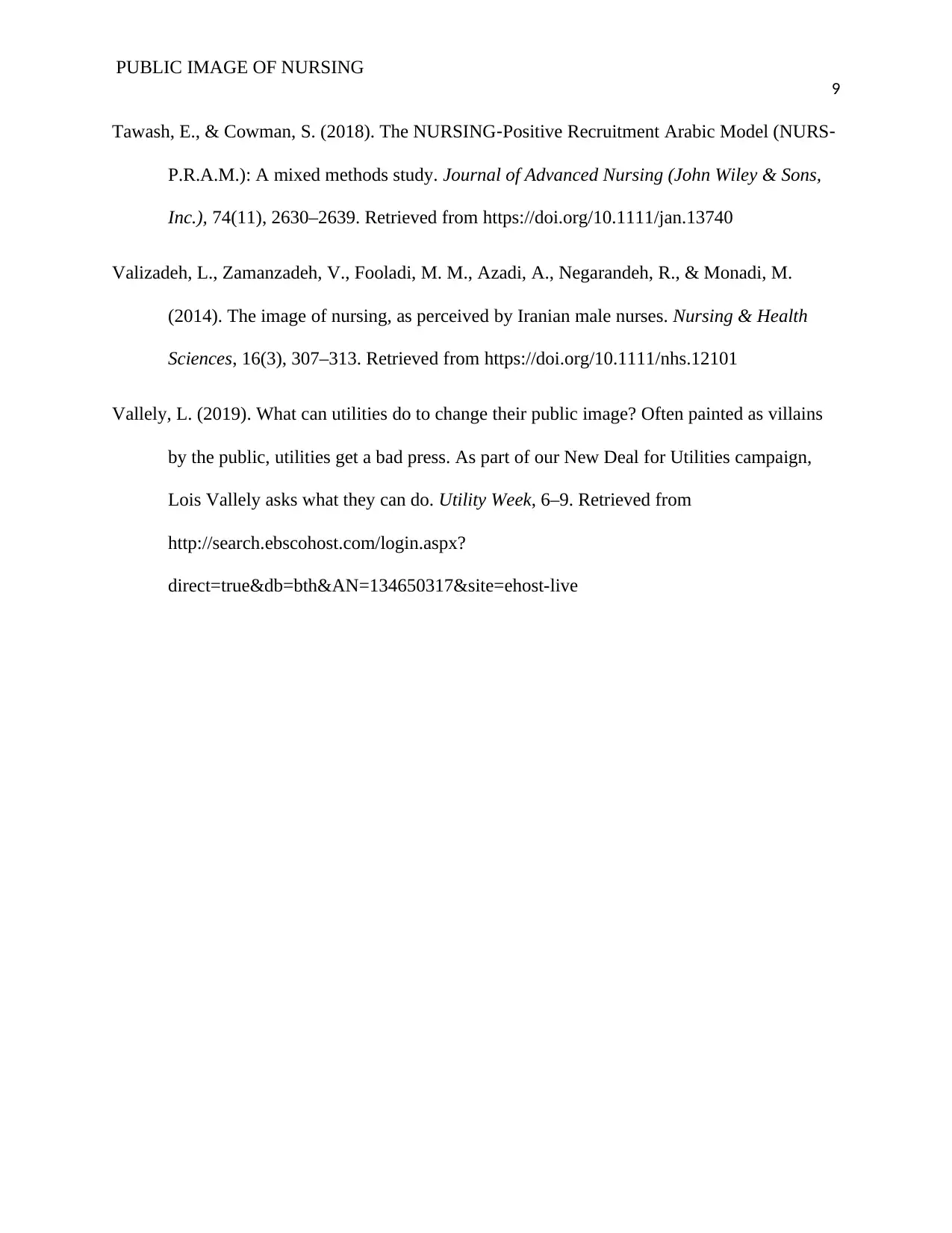
PUBLIC IMAGE OF NURSING
9
Tawash, E., & Cowman, S. (2018). The NURSING‐Positive Recruitment Arabic Model (NURS‐
P.R.A.M.): A mixed methods study. Journal of Advanced Nursing (John Wiley & Sons,
Inc.), 74(11), 2630–2639. Retrieved from https://doi.org/10.1111/jan.13740
Valizadeh, L., Zamanzadeh, V., Fooladi, M. M., Azadi, A., Negarandeh, R., & Monadi, M.
(2014). The image of nursing, as perceived by Iranian male nurses. Nursing & Health
Sciences, 16(3), 307–313. Retrieved from https://doi.org/10.1111/nhs.12101
Vallely, L. (2019). What can utilities do to change their public image? Often painted as villains
by the public, utilities get a bad press. As part of our New Deal for Utilities campaign,
Lois Vallely asks what they can do. Utility Week, 6–9. Retrieved from
http://search.ebscohost.com/login.aspx?
direct=true&db=bth&AN=134650317&site=ehost-live
9
Tawash, E., & Cowman, S. (2018). The NURSING‐Positive Recruitment Arabic Model (NURS‐
P.R.A.M.): A mixed methods study. Journal of Advanced Nursing (John Wiley & Sons,
Inc.), 74(11), 2630–2639. Retrieved from https://doi.org/10.1111/jan.13740
Valizadeh, L., Zamanzadeh, V., Fooladi, M. M., Azadi, A., Negarandeh, R., & Monadi, M.
(2014). The image of nursing, as perceived by Iranian male nurses. Nursing & Health
Sciences, 16(3), 307–313. Retrieved from https://doi.org/10.1111/nhs.12101
Vallely, L. (2019). What can utilities do to change their public image? Often painted as villains
by the public, utilities get a bad press. As part of our New Deal for Utilities campaign,
Lois Vallely asks what they can do. Utility Week, 6–9. Retrieved from
http://search.ebscohost.com/login.aspx?
direct=true&db=bth&AN=134650317&site=ehost-live
⊘ This is a preview!⊘
Do you want full access?
Subscribe today to unlock all pages.

Trusted by 1+ million students worldwide
1 out of 9
Related Documents
Your All-in-One AI-Powered Toolkit for Academic Success.
+13062052269
info@desklib.com
Available 24*7 on WhatsApp / Email
![[object Object]](/_next/static/media/star-bottom.7253800d.svg)
Unlock your academic potential
Copyright © 2020–2025 A2Z Services. All Rights Reserved. Developed and managed by ZUCOL.



